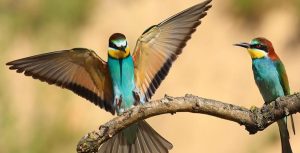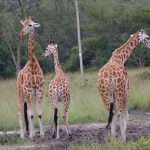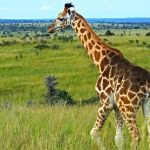
Situated in the Ituri Forest northeast of the Democratic Republic of Congo (DRC), the Okapi Wildlife Reserve is one of the most stunning protected areas in Africa that you should consider visiting in your next vacation. The reserve is surrounded by South Sudan and Uganda and covers an area of over 14000 square kilometers about a 5th of the Ituri forest areas. It is located along the Nepoko, Ituri, and Epulu Rivers that flow via the reserve.
The reserve was established in 1992 and became a UNESCO World Heritage Site in 1997 and offers refuge to Okapis that today make up approximately 5000 in number out of the 30000 individuals in the wild, 4000 Elephants (Loxodonta Africana cyclotis), bongo (Tragelaphus eurycerus), aquatic genet (osbornictis piscivora), giant genet (genetta victoriae), 2000 leopards, 17 primates (13 diurnal and 4 nocturnal) including 7500 chimpanzees (pan troglo, crocodiles as well as forest buffaloes, 308 bird species, water chevrotain and many more. The reserve is credited for its bio-geographical location, a wealth of biotopes, and several unique low-altitude forests.
Around the northern side, the Okapi wildlife reserve features granite rock outcrops and offers refuge to plant species specifically adapted to the microclimate, characterized by several endemic species like the Giant cycad-Encepholarcus Ituriensis. It also inhabits most of the forest ongulates with over 14 species plus the 6 distinct kinds of Cephalophus.

Birding in Okapi Wildlife Reserve Congo
For bird lovers, Okapi Wildlife Reserve also features among the most incredible birding sites in Africa with bird species like the rare Congo Peafowl (Afropavo Congensis) and several endemic species in the Eastern Democratic Republic of Congo (DRC). Okapi Wildlife Reserve’s forest features among the very few most excellent and well-conserved areas in the Congo Basin and its area is regarded as sufficient when it comes to wildlife conservation. It forms part of the bigger forestry area of the Ituri forest that still offers authentic wilderness experiences of a lifetime. This reserve is conserved under the Wildlife Reserve Statute and refuges several indigenous species including the Mbuti and Efe pygmies and the forest ecosystems that are of great value when it comes to economic and cultural experiences in Africa.
There is also a management proposal to cover the 3 management areas within this reserve and this includes the fully protected core zone of about 282000 ha consisting of 20 percent of the reserve in which all the hunting isn’t allowed and an area of 950000 ha for traditional use where self-regulated hunting, using traditional techniques is permitted to cover the basic interests of the humans around the reserve. Permanent installations and agricultural clearing are allowed in the 180000 ha development area which consists of a small band on every side of the number four national road crossing via the central area of the reserve and through the secondary road which connects Mambasa to Mungbere in the eastern boundary of the reserve.
Other plans are also intended to turn the entire reserve into a national park. A buffer zone of 50 kilometers wide has been defined around the whole reserve. The leading management challenges at the reserve include immigration control in the development area, the restricted agricultural encroachment around the 10-kilometer-wide strip located on the road, and making sure that the natives participate in the conservation and management of the reserve. The other challenges include the control of commercial poaching and artisanal mining. Whereas the protected area benefits from the support of several NGOs and other funding, it is imperative to get human and logistical resources to make sure that there is effective management of the reserve and its buffer zones at large.
The best time to visit Okapi Wildlife Reserve
Okapi Wildlife Reserve is best explored around June and August as these months come with a minimal amount of rainfall.
In conclusion, despite the challenges faced Okapi Wildlife Reserve is open for tourism you can pay a visit to it at any time of the year and you will certainly be amazed by incredible wildlife species that you may not easily find in any part of Africa. The reserve is perfect for nature lovers who are planning their vacation to the Democratic Republic of Congo (DRC).


